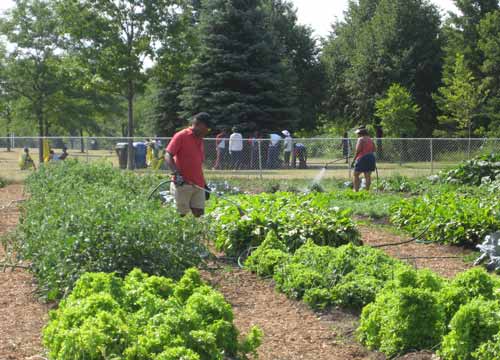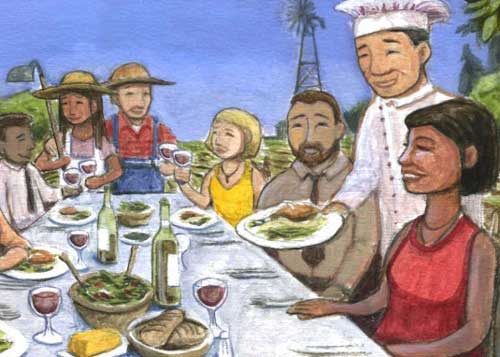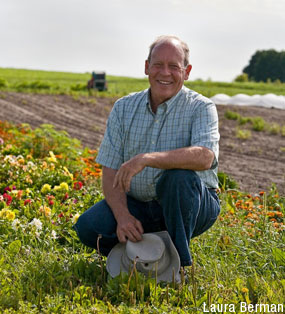Newsletters

August's Good Food Newsletter
A Reminder to Submit your Rouge Park Surveys
In only two weeks we have already had over a thousand hits on the www.agrifoodhub.org website. But we need lots more! Visitors are learning about the many beneficial opportunities such a magnificent resource will bring to our Toronto food community. Each visitor becomes better prepared to submit an informed Park Survey. Thank you for sharing with your networks the need to visit this website and then submit the Park Survey. Now is a good time to send out reminders!
If you have not yet submitted your own Survey, please do it NOW. If you agree that an Agriculture and Food Hub within Toronto’s last agricultural space is important, it is quite acceptable to submit your additional thoughts by submitting another survey. (The Survey closes September 15th.)

With insufficient support, the Urban Park’s farms may just continue to be GMO corn and soybean cash crop farms that benefit only a couple dozen farmers.
After air and water, food is our most essential need. Political actions manage the sustainability of our food; and urban voters direct our politics. In this epoch of rapidly changing climate, economy, and chemistry, urban voters need to both observe and understand the best ways to secure our food supplies. We simply cannot afford to lose this golden opportunity!
Local Food Celebrations and Fundraisers
After a summer like this, our farmers need a great big “Thank You”. (And some extra funds are another form of Thanks.)

Celebrating our farmers with a feast in their fields.
The harvest season commenced with the 3rd annual FarmStart Harvest Table on August 19th at the McVean incubator farm in Brampton. With more amazing musicians than memorable food, the 2nd annual Greenbelt Harvest Picnic goes from noon to nearly midnight on September 1st at Christy Lake Conservation area near Dundas. The 23rd annual Feast of Fields is on September 9th in the Cold Creek Conservation area near Nobleton. Starting on September 15th is the 1st annual series of small (maximum guests 40) Ontario Organic Dinner Parties at various venues and dates. The 6th annual Evergreen/Slow Food Picnic will not take place this year. However, on September 16th at Toronto’s Brick Works there will be a Slow Food Harvest Cook Out – only $10 for members. (So this event is not a fundraiser.)
Preparing your Stories – Starting your Brand
You don’t need to be a Coke or a Nike to have a brand. Actually your business already has a brand. But if you don’t know what it is, it’s probably not doing much for you. A positive brand can help any business. Whether you operate a farm, a restaurant, an artisanal food shop, a food distributor, or a food writer, you will benefit from positive branding.
Building your brand is an important part of the consulting services I can offer. The food business has notoriously low profits, margins, and prices. Building brand equity is a great way to receive higher prices (and thereby increase margins and profits). Security is also increased with improved customer loyalty.
To get started in identifying your brand:
- You and your employees should first start collecting stories that will inform the world about your business values and visions. These will become very useful later in the process. If you have prepared a Vision Statement or Mission Statement, stories that highlight these will be good ones. If you don’t have enough stories, take the time to engage in business activities that can become good stories.
- Identify your business’s core competencies. (Be sure to include your employees as well as some key customers and vendors in this step.) The plain facts can be a starting point, but they do not usually provide compelling stories. It will be easier to treat these competencies as personal characteristics (or a personality). Again, start collecting stories about these characteristics. But make sure they are completely honest and will be perceived as absolutely reasonable.
- Once you have a thorough understanding of what your business is really good at (and the stories to back this up) you are ready for the third step. Carefully characterize your existing good customers. You want to identify:
- what they expect from your business
- what they like about your business
- how they feel about your business
- how they view your business
- Now you can start connecting your own stories with what your good customers most want to hear. Your stories should of course regularly reassure these customers that you can and will fulfill their expectations. But more importantly, your stories must reassure your customers that you can and will also support what they like, feel and view about your business. Understanding these emotional needs and communicating that you are prepared to provide them is the secret to successful branding.
Longer shelf-life
- benefits farmers with extended seasons
- reduces waste in the distribution stream and at home
- supports our economy by reducing our need for imports
After all this is in place, you can then begin to reach out for new customers.
more to come.
| forward to a friend and suggest signing up to receive this newsletter every month. |

